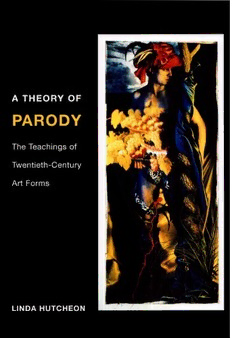
A Theory of Parody. The Teachings of Twentieth-Century Art Forms PDF
Preview A Theory of Parody. The Teachings of Twentieth-Century Art Forms
A THEORY OF PARODY The Teachings of Twentieth-Century Art Forms LINDA HUTCHEON Literary Criticism A THEORY OF PARODY The Teachings of Twentieth-Century Art Forms LINDA HUTCHEON "Linda Hutcheon's thoughtful engagement with the theory of parody picks its way meticulously through this conceptual minefield, to emerge with a convincing map of the terrain. ... A scrupulously reasoned case made more persuasive by the tenacity with which its details have been pur sued." — Terence Hawkes, Times Literary Supplement In this major study of a flexible and multifaceted mode of expression, Linda Hutcheon looks at works of modern literature, visual art, music, film, theater, and architecture to arrive at a comprehensive assessment of what parody is and what it does. Hutcheon identifies parody as a major form of modern self-reflexivity, one that marks the intersection of invention and critique and offers an important mode for coming to terms with the texts and discourses of the past. Looking at works as diverse as Tom Stoppard's Rosenkrantz and Guildenstern Are Dead, Brian de Palma's Dressed to Kill, Woody Allen's Zelig, Karlheinz Stockhausen's Hymnen, James Joyce's Ulysses, and Magritte's This Is Not a Pipe, Hutcheon discusses the remarkable range of intent in modern parody while distinguishing it from pastiche, burlesque, travesty, and satire. She shows how parody, through ironic playing with multiple conventions, combines creative expression with critical commen tary. Its productive-creative approach to tradition results in a modern recoding that establishes difference at the heart of similarity. In a new introduction, Hutcheon discusses why parody continues to fascinate her and why it is commonly viewed as suspect—for being either too ideologically shifty or too much of a threat to the ownership of intel lectual and creative property. Linda Hutcheon, a professor of English at the University of Toronto, is the author of Irony's Edge: The Theory and Politics of Irony, Narcissistic Narrative: The Metafictional Paradox, and other books. UNIVERSITY OF ILLINOIS PRESS Urbana, Chicago & Springfield / www.press.uillinois.edu ISBN 978--0-252-06938-;1 1 90000 Cover illustration: The Caravaggio by Evergon. Courtesy of the Canadian Museum of Contemporary Photography. 9 780252 069383 A THEORY OF PARODY A THEORY OF PARODY THE TEACHINGS OF TWENTIETH-CENTURY ART FORMS LINDA HUTCHEON UNIVERSITY OF ILLINOIS PRESS Urbana and Chicago First Illinois paperback, 2000 © 1985,2000 by Linda Hutcheon Reprinted by arrangement with the author All rights reserved Manufactured in the United States of America @ This book is printed on acid-free paper. Library of Congress Cataloging-in-Publication Data Hutcheon, Linda, 1947- A theory of parody : the teachings of twentieth-century art forms / Linda Hutcheon. p. cm. Originally published: New York : Methuen, 1985. Includes bibliographical references and index. ISBN 0-252-06938-2 (pbk. : alk. paper)/ISBN 978-0-252-06938-3 1. Parody in art. 2. Aesthetics, Modern—20th century. 3. Arts, Modem—20th century. I. Title. NX650.P37H87 2000 700'.1—dc21 00-030261 P 6 5 4 incipit parodia Nietzsche CONTENTS List of illustrations ix A new introduction, an old concern xi Acknowledgments xix 1 Introduction \ 2 Defining parody 30 3 The pragmatic range of parody 50 4 The paradox of parody 69 5 Encoding and decoding: the shared codes of parody 84 6 Conclusion: the world, the parodie text, and the theorist 100 Bibliography 218 !ndex 136
